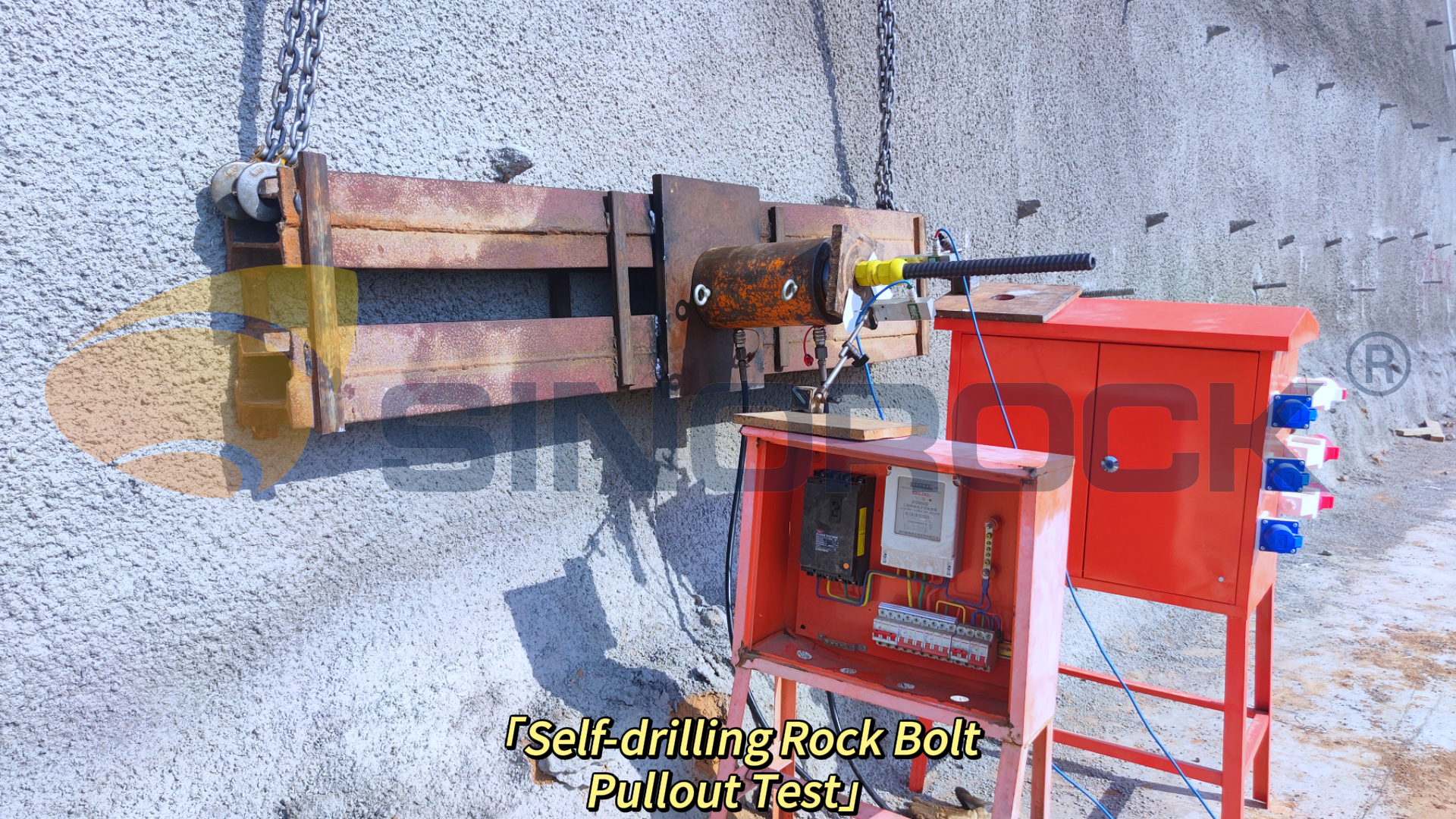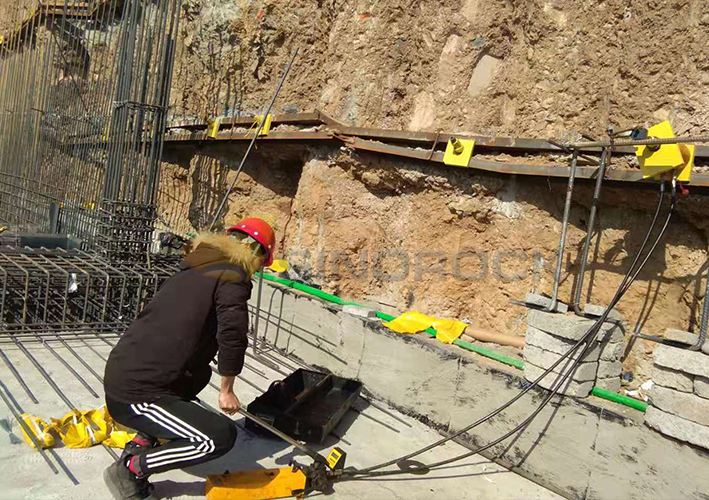Self-Drilling Anchor Bolt Load Testing Setups and Loading Process
Time:2024-06-13From:sinorock View:
Introduction
Self-drilling anchor bolts have become indispensable in modern construction and geotechnical engineering due to their ability to provide robust structural stability in challenging soil and rock conditions. Their effectiveness hinges on various factors, including the adhesive properties of the interface, soil type, construction methods, and rigorous load testing setups. This article delves into the intricacies of load testing setups for self-drilling anchor bolts, the loading process, and the importance of these tests in ensuring the reliability and integrity of construction projects.
Importance of Load Testing in Construction
Load testing is a critical step in construction projects that involve self-drilling anchor bolts. These tests provide essential data on the load-bearing capacity and performance of the bolts under different stress conditions. The primary objective of load testing is to ensure that the anchor bolts can withstand the forces they will encounter once the structure is in use, thereby preventing structural failures and ensuring safety and longevity.
Load Testing Setups for Self-Drilling Anchor Bolts
Various load testing setups are employed to evaluate the performance of self-drilling anchor bolts. These setups simulate different stress conditions to provide a comprehensive understanding of the bolt's behavior under actual working conditions. The primary load testing setups include:
1. Compression Load Test
The compression load test is designed to measure the ability of self-drilling anchor bolts to withstand axial loads. This test is crucial for determining the load-bearing capacity of the bolts under compressive forces, which is essential for ensuring the structural stability of foundations, retaining walls, and other construction elements that rely on vertical support.
Procedure
- Setup: The anchor bolt is installed in a test apparatus that simulates the actual installation conditions.
- Loading: A compressive load is gradually applied to the bolt using hydraulic jacks or other loading devices.
- Measurement: The deformation of the bolt and the applied load are recorded using precise instrumentation.
Significance
The results of the compression load test help engineers determine whether the self-drilling anchor bolts can bear the designed loads without excessive deformation or failure. This test is particularly important in projects where vertical loads are significant.
2. Pull-out Test
The pull-out test is indispensable when self-drilling anchor bolts are used to reinforce structures. This test assesses the pull-out resistance, which indicates the adhesive strength between the grouting body and the self-drilling anchor bolts, as well as the shearing strength between the surrounding rocks.

Procedure
- Setup: The anchor bolt is installed in a pre-drilled hole, and grout is injected to fill the annular space between the bolt and the surrounding material.
- Loading: A tensile load is applied to the bolt, pulling it out of the grouted body.
- Measurement: The force required to pull out the bolt and the displacement are recorded.
Outcomes
- Adhesive Strength: If the bolt is pulled out from the grouting body, the test measures the adhesive strength between the grout and the bolt.
- Shearing Strength: If the bolt is pulled out with the grouting body, it indicates the shearing strength between the grout and the surrounding rocks.
- Tensile Strength: If the bolt breaks during the test, it signifies that the bearing capacity is controlled by the tensile strength of the bolt.
3. Lateral Load Test
The lateral load test evaluates the performance of self-drilling anchor bolts under horizontal forces. This test is critical for applications where the bolts are subjected to lateral loads, such as in slope stabilization and retaining wall construction.
Procedure
- Setup: The anchor bolt is installed horizontally in the test setup.
- Loading: A lateral load is applied to the bolt, simulating the forces it would encounter in actual conditions.
- Measurement: The lateral displacement and applied load are recorded.
Significance
The results of the lateral load test provide valuable insights into the ability of the anchor bolts to resist horizontal forces, ensuring the stability of structures subject to such loads.
4. Deformation Instrumentation
Deformation instrumentation involves the use of precise measuring devices to monitor the behavior of self-drilling anchor bolts under load. This setup provides data for assessing the performance and long-term structural stability of the bolts.
Instruments Used
- Strain Gauges: Measure the strain within the bolt as it is loaded.
- Displacement Transducers: Record the displacement of the bolt under load.
- Data Loggers: Collect and store data for analysis.
Importance
Deformation instrumentation helps in understanding how self-drilling anchor bolts behave under various loading conditions, providing critical data for designing and optimizing anchorage systems.
Analyzing the Loading Process of Self-Drilling Anchor Bolts
Understanding the loading process of self-drilling anchor bolts is crucial for ensuring their effectiveness in geotechnical engineering projects. The loading process can be divided into three distinct stages:
1. The First Stage
At the initial stage of self-drilling anchor bolt installation, the grouting process is completed, but the bonding force between the grout and the soil layer has not yet fully formed. Consequently, the anchor bolts bear minimal force during this stage.
Key Considerations
- Grouting Quality: The quality and consistency of the grout are critical at this stage.
- Soil Conditions: The type of soil and its initial interaction with the grout influence the bonding process.
2. The Second Stage
As excavation depth increases, the slurry bonds the self-drilling anchor bolts to the stratum. Tension gradually develops within the anchor bolts, concentrating on the bonding position. The closer the anchor bolts are to the stratum, the greater the tension they experience.
Key Considerations
- Bonding Strength: The development of bonding strength between the grout and the soil.
- Stress Distribution: The distribution of tension along the length of the anchor bolt.
3. The Third Stage
Once sufficient depth is reached, most parts of the self-drilling anchor bolts are within the slip crack range. During this stage, the internal force decreases from the middle to both sides.

Key Considerations
- Slip Crack Range: The extent of the slip crack range and its impact on the anchor bolt.
- Force Distribution: The decrease in internal force from the middle to the sides of the anchor bolt.
Factors Influencing the Performance of Self-Drilling Anchor Bolts
The performance of self-drilling anchor bolts is influenced by several factors, including the type of soil or rock, grouting pressure, and construction methods. Understanding these factors is essential for optimizing the use of anchor bolts in construction projects.
1. Soil and Rock Type
Different types of soil and rock exhibit varying adhesive and shearing strengths, affecting the performance of self-drilling anchor bolts. For example, sandy soils may require different grouting techniques compared to clayey soils.
2. Grouting Pressure
The pressure at which grout is injected influences the bonding strength between the grout and the soil or rock. Higher grouting pressures can improve the penetration of grout into the surrounding material, enhancing the bond.
3. Construction Methods
The methods used during the installation of self-drilling anchor bolts, such as drilling techniques and grout mixing, play a crucial role in their performance. Proper installation ensures that the bolts achieve their designed load-bearing capacities.
Case Studies and Applications
Case Study 1: Slope Stabilization
In a project involving slope stabilization, self-drilling anchor bolts were used to reinforce the slope and prevent landslides. The bolts were subjected to pull-out tests to ensure they could withstand the anticipated loads. The results confirmed that the bolts provided adequate reinforcement, ensuring the stability of the slope.
Case Study 2: Retaining Wall Construction
During the construction of a retaining wall, self-drilling anchor bolts were installed to provide lateral support. Lateral load tests were conducted to evaluate the performance of the bolts under horizontal forces. The tests demonstrated that the bolts could resist significant lateral loads, contributing to the wall's stability.
Best Practices for Load Testing and Installation
To ensure the optimal performance of self-drilling anchor bolts, it is essential to follow best practices during load testing and installation.
1. Thorough Site Investigation
A comprehensive site investigation should be conducted to understand the soil and rock conditions. This information is critical for designing appropriate load testing setups and selecting suitable anchor bolts.
2. Proper Grouting Techniques
Using the correct grouting techniques and pressures is vital for achieving a strong bond between the grout and the surrounding material. Careful mixing and injection of grout can significantly enhance the performance of the anchor bolts.
3. Regular Monitoring and Maintenance
Regular monitoring of the installed anchor bolts is essential to ensure their long-term performance. Deformation instrumentation and periodic inspections can help detect any issues early and allow for timely maintenance.
Conclusion
Self-drilling anchor bolts are crucial components in geotechnical engineering and construction, providing essential support in various applications. The effectiveness of these bolts depends on rigorous load testing setups and a thorough understanding of the loading process. By adhering to best practices and considering the factors influencing their performance, engineers and construction professionals can ensure the reliability and integrity of their projects. Sinorock's expertise in manufacturing high-quality self-drilling anchor bolts and commitment to rigorous testing procedures make them a trusted partner for construction professionals seeking reliable anchoring solutions. For any needs or questions in the field of geotechnical anchoring, please contact Sinorock at sinorock@sinorockco.com.sinorock@sinorockco.com.
latest news
-

- What Are the Applications of SDA Bolts in Hydropower Stations?
- Time:2025-08-21From:This Site
- Learn how self-drilling anchor bolts enhance slope stability, tunnel support, and dam reinforcement in complex geological conditions at hydropower stations. Optimize hydropower projects with efficient, cost-effective, and eco-friendly solutions.
- View details
-

- Slope Stabilization with SDA Bolts: Benefits & Applications
- Time:2025-08-19From:This Site
- Discover how self-drilling anchor bolts (SDA bolts) provide superior slope stabilization for highways, railways, and tunnels. Learn their key benefits, installation process, and real-world applications in loose or collapsible soils.
- View details
-

- How Self-Drilling Rock Bolts Enhance Tunnel Support in Fractured Rock?
- Time:2025-08-15From:This Site
- Discover how self-drilling rock bolts enhance tunnel support in fractured rock. Learn their benefits, installation steps, and real-world applications for safe, efficient tunneling.
- View details
-

- Sinorock 2025 Quality Month | Strengthening Quality Foundations, Empowering Product Excellence
- Time:2025-08-13From:This Site
- Sinorock’s 2025 Quality Month, themed “Strengthening Quality Foundations, Empowering Product Excellence,” successfully concluded, reinforcing our commitment to superior product quality.
- View details
-

- Sinorock Safety Month 2025 | Everyone Speaks Safety, Everyone Can Respond
- Time:2025-07-03From:This Site
- Sinorock Safety Month 2025, centered on the theme "Everyone Speaks Safety, Everyone Can Respond - Spot Workplace Hazards," has wrapped up successfully!
- View details
-

- Quality Control: the Vital Factor of A SDA Bolt Factory
- Time:2025-01-09From:This Site
- Sinorock’s comprehensive quality control system, from supplier management to outgoing inspections, ensuring the highest standards for self-drilling anchor bolts in construction.
- View details
-

- Sinorock Invites You to Explore Proven Self-Drilling Anchor Bolt Solutions at bauma 2025
- Time:2025-03-07From:This Site
- From April 7–13, 2025, explore Sinorock’s Self-drilling anchor bolt solution at Booth C2.513/4 in Hall C2 of the Messe München Exhibition Center (Munich, Germany).
- View details
-
.jpg)
- SINOROCK to Attend EXPOMINA PERÚ 2024 in Lima, Peru
- Time:2024-08-10From:This Site
- Sinorock to Attend EXPOMINA PERÚ 2024 in Lima, Peru
- View details
-
.jpg)
- SINOROCK to Participate in MINING AND METALS CENTRAL ASIA 2024
- Time:2024-08-08From:This Site
- SINOROCK to Participate in MINING AND METALS CENTRAL ASIA 2024
- View details
 Download
Download 


